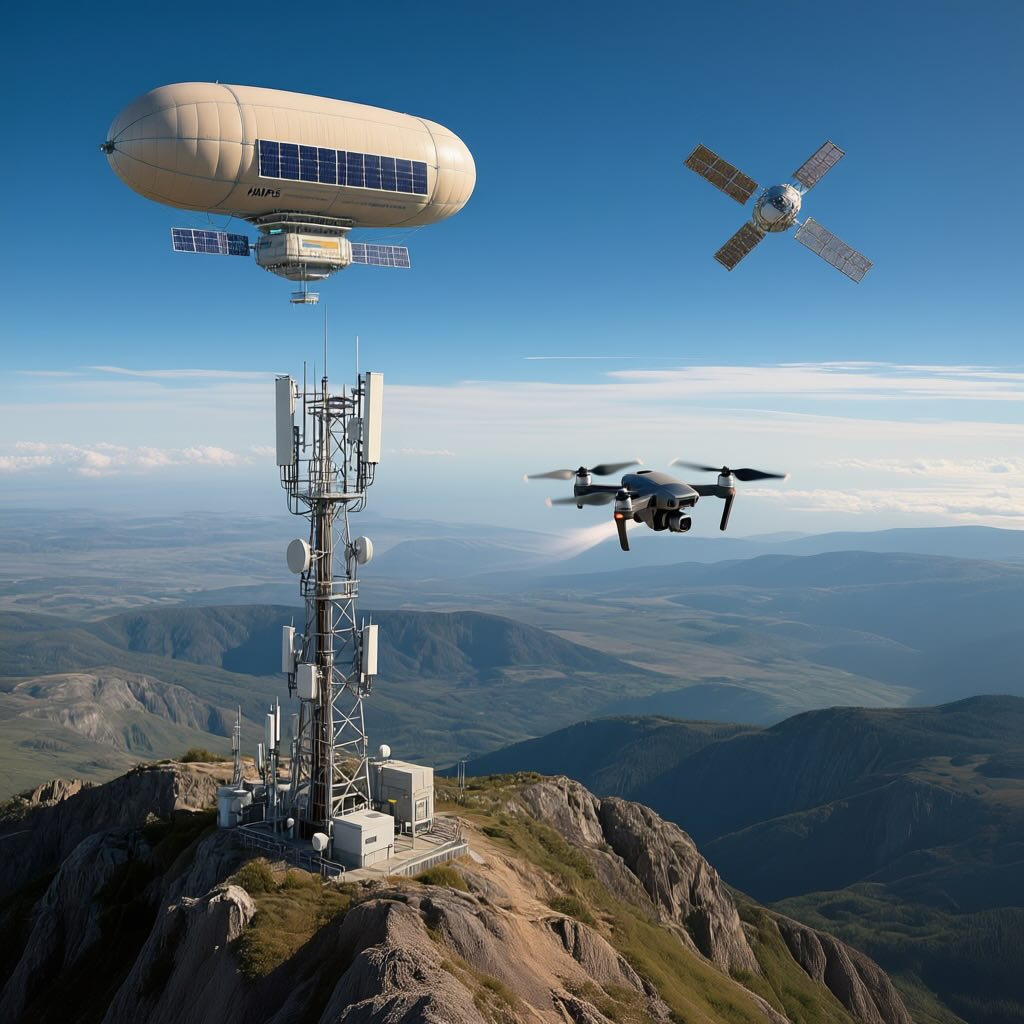
A recent research proposes a multi-tier 6G network combining terrestrial towers, UAVs, high-altitude platforms, and satellites with AI-powered cell-switching to cut energy use, expand coverage, and balance latency for sustainable future connectivity.
Mobile networks are getting busier every year. Think about how many devices you use daily—your phone, smartwatch, laptop, maybe even a VR headset. Now multiply that by billions of people worldwide! 📱💻⌚
The coming 6G era (expected around 2030) will push things even further with holographic calls, autonomous vehicles, remote surgeries, and industrial IoT. These futuristic applications need not just faster internet, but also sustainable and energy-efficient networks.
Here’s the problem:
So, how can we keep networks fast and green? One smart trick is called cell-switching.
Imagine city streetlights at night. Some streets are crowded, so the lights stay on. Others are empty, so the lights could be dimmed or turned off. Cell-switching works the same way for mobile networks:
This saves energy 💡. But there’s a catch:
That’s where the new research steps in.
The paper proposes an upgrade: don’t just rely on towers on the ground. Instead, combine terrestrial networks with non-terrestrial ones—things that fly or orbit above us 🚁🛰️.
The NTN family includes:
By mixing these with traditional towers, we get a multi-tier cell-switching system.
The researchers designed a four-layered architecture to balance energy and latency:
👉 Each tier has its strengths. For example:
Here’s the twist: not all internet is equal.
That’s why 6G introduces HRLLC (Hyper-Reliable Low-Latency Communication). To meet this, the system must know:
The multi-tier system makes context-aware decisions:
The study introduces two operating modes:
👉 In real networks, operators could switch between these modes depending on demand.
Managing such a complex system isn’t easy. You need to know:
This is where AI and Generative AI (GenAI) come in 🤖✨.
Key roles of AI in 6G cell-switching:
⚠️ Challenge: AI also introduces privacy and security concerns. More data means more risk of breaches. Solutions like federated learning and quantum cryptography are being explored.
The researchers ran simulations in a 1 km² urban area with different user densities.
Findings:
The study opens exciting doors for the future of mobile connectivity:
Of course, some hurdles remain:
This research shows that integrating terrestrial and non-terrestrial networks into a multi-tier system is key for sustainable 6G.
By blending towers, drones, high-altitude platforms, and satellites, we can:
The future of 6G won’t just be about speed—it’ll be about intelligence, flexibility, and sustainability. And thanks to innovations like these, we’re one step closer.
📡 Base Station (BS) - The “cell tower” that connects your phone or device to the mobile network. Think of it as a Wi-Fi router, but on steroids for the whole city. - More about this concept in the article "How 6G Will Keep Stadiums Online 🏟️ 📡 Merging Satellites and Smart Surfaces for Ultimate Connectivity".
🛰️ Non-Terrestrial Networks (NTN) - Networks that don’t sit on the ground—they float or orbit! Includes drones (UAVs), balloons/planes in the stratosphere (HAPS), and satellites.
🏗️ Terrestrial Networks (TN) - The traditional mobile networks we use today—ground-based towers, small cells, and antennas spread across cities and towns.
🔄 Cell-Switching - A power-saving trick: turn off underused base stations and shift users to other active ones. Like turning off lights in empty rooms.
🚁 UAV (Uncrewed Aerial Vehicle) - Basically drones that act as flying mini-cell towers, deployed during emergencies, concerts, or when extra coverage is needed. - More about this concept in the article "UAV Radar Imaging Reimagined 🚁 for Smarter Skies".
☁️ HAPS (High Altitude Platform Stations) - Solar-powered balloons or aircraft that hover about 20 km above Earth, acting like “giant floating cell towers in the sky.” - More about this concept in the article "Revolutionizing UAV Networks with AI: Smarter Task Assignment for a Dynamic World 📡 🚁".
🌍 Satellite Networks - Orbiting networks that cover entire regions or even the globe. Newer low-orbit satellites can even connect directly to your phone.
⚡ Latency - The delay between sending and receiving data. For video calls, it’s the awkward pause before someone hears your “Hello.” - More about this concept in the article "5G Meets Virtual Reality 🎮 Smoother Immersion".
⏱️ HRLLC (Hyper-Reliable Low-Latency Communication) - A 6G feature that guarantees ultra-low delay and extreme reliability—vital for things like self-driving cars and remote surgeries.
🤖 Generative AI (GenAI) - AI that can create or transform data—like compressing videos for smoother streaming or predicting where users will move in a network. - More about this concept in the article "Generative AI vs Wildfires 🔥 The Future of Fire Forecasting".
🌱 Sustainable Networking - Designing networks that use less energy, rely on renewables (like solar HAPS), and reduce carbon footprints while still staying fast.
Source: Metin Ozturk, Maryam Salamatmoghadasi, Halim Yanikomeroglu. Integrating Terrestrial and Non-Terrestrial Networks for Sustainable 6G Operations: A Latency-Aware Multi-Tier Cell-Switching Approach. https://doi.org/10.48550/arXiv.2508.10849
From: Ankara Yıldırım Beyazıt University; Carleton University.